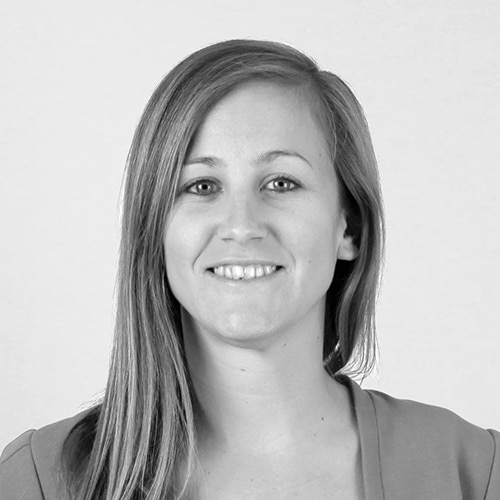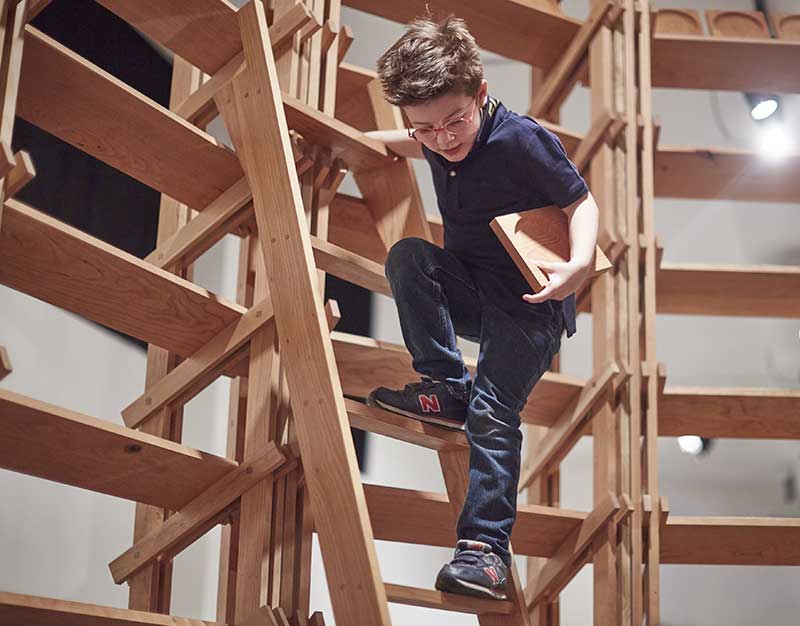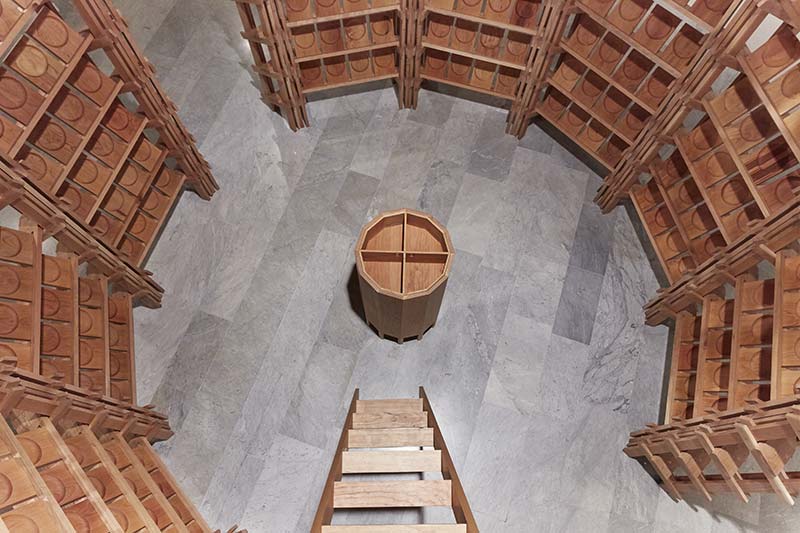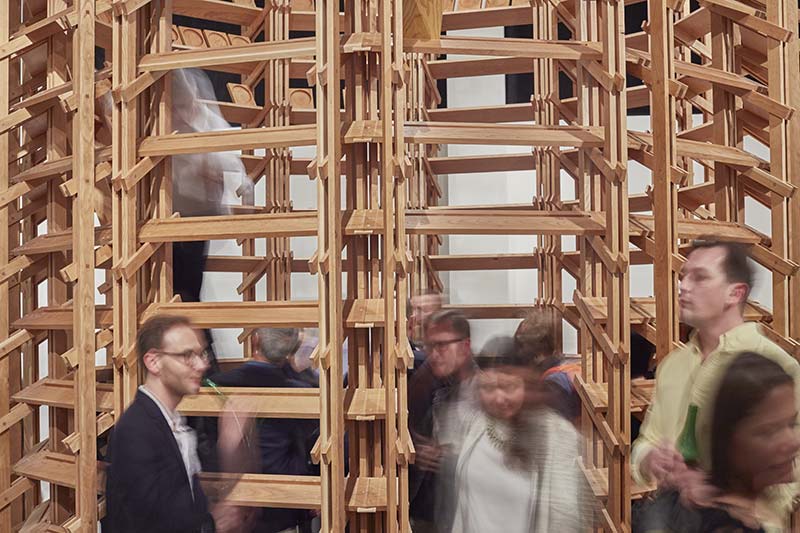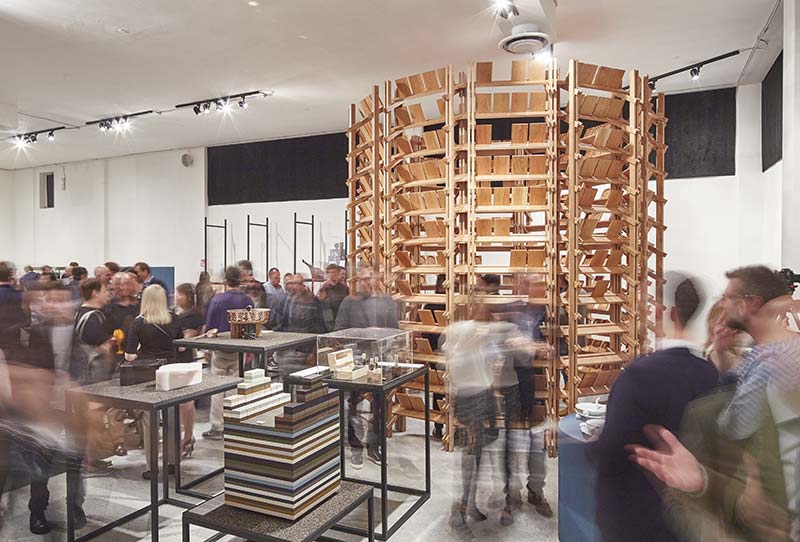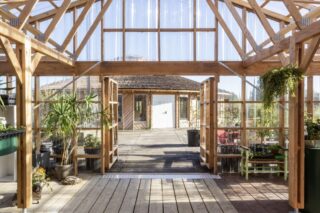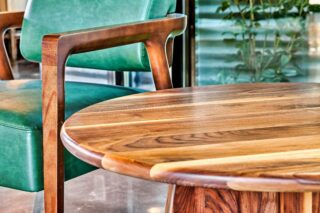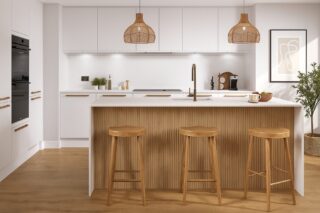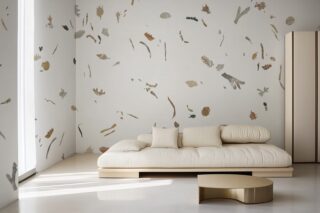The words sustainability and eco-friendly should be used with care. Many architects and designers are aware of environmental impacts and the importance of identifying the best methods and materials. They understand the research and testing involved and appear more than willing to work together to bring it about.
Together, Benchmark and American Hardwood Export Council (AHEC) were asked to participate in the Wallpaper* Handmade Exhibition during Milan’s Salone del Mobile 2015. Benchmark, known for its rich experience in sustainable timber sourcing and the transformation of the British furniture industry, and American Hardwood, the leading international trade association for the U.S. hardwood industry, came up with the Rotunda Serotina.
The collaborators were to create a towering structure of food plates, articulating the technical and aesthetic qualities of American cherry. The 3.7-meter-high installation portrayed airy columns of shelves arranged in a cylindrical form with a single ladder that could be slid on the inside from one shelf to the next. Cherry wood snack trays were placed in rows on each shelf and visitors could take one home as limited-edition samples from the exhibition. Not one of the 526 trays were left behind. ArchiExpo’s team may have taken the last one.
Sean Sutcliffe, co-founder of Benchmark furniture, along with Terence Conran, and David Venables, European director of AHEC, spoke to ArchiExpo about their contribution to the Wallpaper* Handmade Exhibition and the importance of rethinking wood.
ArchiExpo e-mag: Can you tell us about the Rotunda Serotina and your use of cherry?
Sean Sutcliffe: The Rotunda Serotina was an invitation project from Wallpaper* Handmade. They paired up the Swedish architects Kolman Boye with us at Benchmark as a design and make team and brought David in to sponsor the thing. The whole thing was going to be about wood so the American Hardwood’s participation was vital. It’s what it’s all about: the wood, the life cycle assessment and working with American cherry wood, which is a timber that, throughout the ‘80s and early ‘90s was very popular. For no better reason than for fashion, it has become considerably less popular to the point where there’s a massively reduced market for it.
David Venables: I was really surprised that the global statistics are quite low. If you underutilize your resource, then actually that’s not healthy for the forest.We talk about sustainability in growing trees and with all the talk, it’s always about how many trees you plant. Do you have a certificate? It’s not about this. It’s about the balance of what you use in the market to what your forest is growing. If this isn’t maintained, it’ll never be sustainable no matter how many certificates you have. It’s also not just about growing the trees, but how you use the material. So a lot of the projects we’ve done, both with Sean and other partners and collaborators, there are always messages about the material. Discussing cherry, which we’ve done for over two or three years now, we’ve pledged to do more projects on cherry, and Wallpaper* gave us the opportunity to do so.
ArchiExpo e-mag: Where did the material for this project come from?
David Venables: I asked my industry, my sawmills in the United States to send me a container of wood I could do projects with. I told them I didn’t want their best wood, I want everything including the yard sweepings. Send me the rubbage, send me the good stuff, send me everything. So we ended up with a lot of material that has a huge color and character.
Last night when we were at the structure giving out the plates and the food, the reaction was extraordinary. Everyone was asking for the dramatic plates. The rustic look is in. It’s going to be not just cherry coming back, but how we present it. We know there are companies looking at it and wondering how they can bring it back into the market, so our timing is very good.
ArchiExpo e-mag: What did Wallpaper* ask you to create?
Sean Sutcliffe: So the brief from Wallpaper* was for the architects to provide a platform for serving food during the show. They call it a sweet shop or a pick-and-mix. It went through the evolution of a traditional sweet shop countering cabinet and then through discussion, the [architects] came over to the U.K., and together we decided to do something far more architectural.
One of the key intentions was to try and engineer a way that everyone that saw it could take a piece of it away. This then was something that got eaten, consumed in every sense. Something that during the course of the evening or during the course of the Salone, bit by bit, would be taken away. We developed this idea of something that gets consumed, decayed like the idea of a carcass.
- Courtesy of Benchmark furniture
- Courtesy of Benchmark furniture
- Courtesy of Benchmark furniture
- Courtesy of Benchmark furniture
- Courtesy of Benchmark furniture
ArchiExpo e-mag: What challenges did you face in building the structure?
Sutcliffe & Venables: It’s 3.7 meters high and about 3.5 meters in diameter. We began to realize the scale, and the fact there’s very little glue. Normally when you build a structure that you need to put some kind of pressure on, you would use structural glue. But [Venables] wanted to make it with the traditional furniture techniques, meaning dry joints and pegs, so it can be easily taken down and be reused. With this in mind and the fact we were going to have to climb up the ladder from the inside to take plates down and to lean on it, we had it fully, structurally tested by Arup, leading engineering consultants whose work has a lot to do with structures. We did the structural modeling of it and then they came and did some testing. You have to be 100% sure.
Sean Sutcliffe: [Arup] works a lot with timber-framed structures. They’ve worked a lot with barn structures. One of the things about such structures is timber needs lengthening so we started looking at traditional jointing techniques, and I’ve done a lot of work with Japanese joinery. I got all my Japanese joints out. We started using dry jointing and using square pegs because that was what the Japanese used for getting shear rigidity into their jointing. It’s not the easiest thing to do, but I think there are 800 square peg joints in [Rotunda Serotina].
David Venables: Our wish was to do it without glue at all. That wasn’t going to be very easy. We used some glue in some of the subsections, but then we used all dry joints so it can be dismantled, packed up in 12 boxes and taken elsewhere.
ArchiExpo e-mag: What about the life cycle assessment?
Sean Sutcliffe: One of the reasons we like to work with American Hardwood is that they’ve done life cycle assessments on their stock from the forest. The input assessments as it arrives in our workshop are calculated and validated. We then add in all our input as manufacturers. So we add in any input in terms of other material, energy use (from a renewable or nonrenewable source) and wastage.
Wastage of the timber is critical because we power and heat all our workshops, which are really big workshops, on biomass. Our first choice is to use wastage in its second life for smaller products, but if it can’t be reused for a second life, we send it to biomass. That, of course, accumulates carbon credit so we get sequestered carbon that’s locked up in the timber.
A cubic meter of cherry wood locks up a ton of CO2. The structure itself has a lot of carbon locked up in it. Then the biomass displaces carbon fuel for vanishing purposes and we get a credit on that. The net result is that the whole of the Rotunda Serotina ends up being carbon positive or carbon neutral.
David Venables: Wood is the only material that is both a product and a fuel.
THE WISH LIST
A highly received project in 2014, an example of bringing architects and designers together in the learning process, The Wish List focused on one raw material: wood. The project was launched by the London-based furniture brand Benchmark and American Hardwood Export Council. Ten leading designers, including architects, teamed up with a young designer. The leading designer asked from the young designer an object they’d always wished for. Zaha Hadid, for example, requested tableware and young Gareth Neal used American white oak to create a water-carafe style vase.
“Wood has shaped our lives,” Terence Conran states in the video for The Wish List. “To me, you can’t design something properly unless you understand how it’s made—and indeed, not only made, but used.”
Environmental impacts were measured during the building process with the goal to spread better understanding and appreciation of the diverse virtues of American hardwoods and their environmental credentials. This project, exhibited at the V&A during the 2014 London Design Festival, grew from another project Benchmark housed two years prior called Out of the Woods.

